11 Herbal Teas For Throat Redness

Herbal teas can be a great way to soothe a sore throat.
Some herbs, like Echinacea purpurea, have anti-inflammatory properties that can help reduce swelling and ease pain in the throat. Glycyrrhiza glabra, also known as licorice root, is another herb that can help calm a sore throat due to its soothing properties. It can also help to reduce inflammation and kill off bacteria that can cause infection. Zingiber officinale, or ginger, is another herb that can be used to make a tea that helps to soothe a sore throat.
Ginger has anti-inflammatory properties and can also help to thin out mucus, making it easier to cough up and clear out of the throat. When you drink these herbal teas, you can feel the soothing effects on your throat, and your body can start to heal faster. These herbal teas are also a natural and chemical-free way to take care of your throat. They don't have any harsh side effects like some over-the-counter medications can have.
Drinking these teas can be a great way to take care of your health, especially during the cold and flu season.
- 1. Echinacea purpurea
- 2. Glycyrrhiza glabra
- 3. Zingiber officinale
- 4. Thymus vulgaris
- 5. Eucalyptus globulus
- 6. Sambucus nigra
- 7. Mentha x piperita
- 8. Salvia officinalis
- 9. Lavandula angustifolia
- 10. Achillea millefolium
- 11. Rosmarinus officinalis
1. Echinacea purpurea

Echinacea purpurea teas contains alkylamides, glycosides, and phenolic acids, which are key bioactive constituents responsible for its medicinal properties.
These compounds have anti-inflammatory properties that help reduce swelling and redness in the throat. The alkylamides in Echinacea purpurea teas have been shown to inhibit the production of pro-inflammatory enzymes, which contribute to throat irritation. The glycosides, particularly echinacoside, have been found to have immunomodulatory effects, helping to regulate the body's immune response and alleviate throat redness.
By reducing inflammation and regulating the immune system, Echinacea purpurea teas can provide relief from throat redness and discomfort.
- Gather 2 tablespoons of dried Echinacea purpurea flowers.
- Heat 1 cup of water in a pot until it starts to boil.
- Add the dried flowers to the boiling water and let it simmer for 5-7 minutes.
- Strain the tea into a cup using a fine-mesh sieve or cheesecloth.
- Let the tea cool down and drink it as needed to help soothe throat redness.
2. Glycyrrhiza glabra

Glycyrrhiza glabra teas contains compounds like glycyrrhetic acid and flavonoids.
These compounds have anti-inflammatory properties, which help to reduce swelling in the throat and alleviate redness. The flavonoids, specifically quercetin and kaempferol, have antioxidant properties that protect the throat from oxidative stress and damage. The saponins in Glycyrrhiza glabra teas also have soothing effects, which can calm irritated tissues in the throat and promote healing.
By reducing inflammation and promoting healing, Glycyrrhiza glabra teas can provide relief from throat redness.
- Gather 1 cup of water, 1 tablespoon of dried Glycyrrhiza glabra root, and a tea infuser.
- Boil the water in a pot and let it cool for 1 minute.
- Add the dried Glycyrrhiza glabra root to the tea infuser.
- Steep the root in the water for 5-7 minutes, then remove the infuser.
- Strain the tea into a cup and drink it while it's warm to soothe throat redness.
3. Zingiber officinale

Zingiber officinale teas contains gingerols and shogaols, which are active constituents that help reduce throat redness.
These compounds have anti-inflammatory properties, which reduce swelling and ease pain in the throat. Shogaols, in particular, have been shown to inhibit the production of pro-inflammatory enzymes, further reducing inflammation. Gingerols also have antioxidant properties, which help protect the throat from damage caused by free radicals.
By reducing inflammation and protecting the throat, Zingiber officinale teas can provide relief from throat redness and discomfort.
- Gather 1 cup of water and 1 tablespoon of fresh Ginger root (Zingiber officinale)
- Wash the Ginger root and peel it. Slice it thinly
- Boil the water in a pot and add the sliced Ginger root. Let it simmer for 5-7 minutes
- Strain the tea into a cup using a fine-mesh sieve or cheesecloth
- Drink the tea warm or at room temperature to help soothe throat redness
Zingiber Officinale Tea on Amazon
FGO Organic Ginger Tea, 100 Count, Eco-Conscious Tea Bags, Caffeine Free, Packaging May Vary (Pack of 1)
Disclaimer: We earn a commission if you click this link and make a purchase at no additional cost to you.
4. Thymus vulgaris
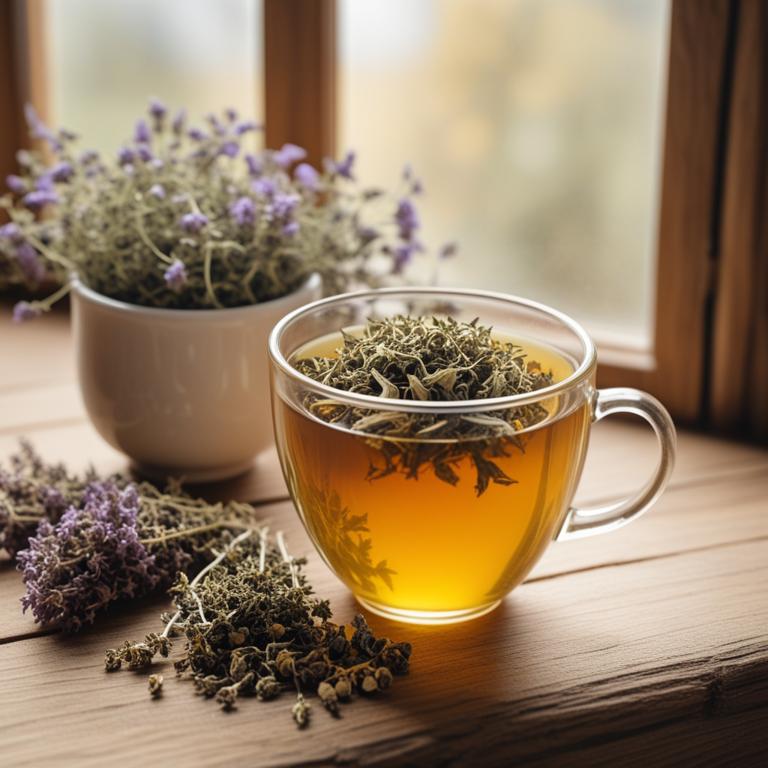
Thymus vulgaris teas contains thymol and carvacrol, two potent bioactive compounds that make it effective in soothing throat redness.
Thymol has anti-inflammatory properties that help reduce swelling and irritation in the throat, while carvacrol has antimicrobial properties that combat infections that can cause redness and discomfort. The antiseptic and antibacterial properties of thymol and carvacrol also help prevent the growth of bacteria and other microorganisms that can exacerbate throat redness. Thymus vulgaris teas has a decongestant effect that helps ease congestion and promotes a healthy flow of mucus, further alleviating throat redness.
By reducing inflammation, preventing infections, and promoting healthy mucus flow, Thymus vulgaris teas provides quick relief from throat redness.
- Gather 1 cup of fresh Thymus vulgaris leaves, or 1 teaspoon of dried leaves.
- Boil 1 cup of water in a pot.
- Add the Thymus vulgaris leaves to the boiling water.
- Reduce heat and let it simmer for 5-7 minutes.
- Strain the tea and drink 1/2 cup, 2-3 times a day for throat redness.
5. Eucalyptus globulus
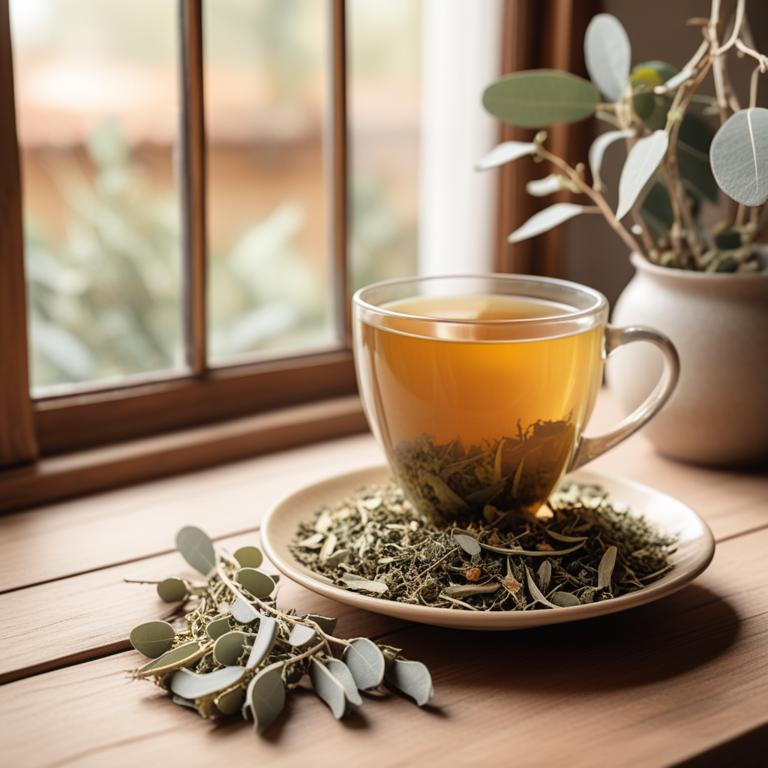
Eucalyptus globulus teas contains bioactive compounds like eucalyptol and camphor, which have anti-inflammatory properties.
These compounds help reduce swelling and ease pain in the throat, making it a popular remedy for sore throats. The decongestant properties of eucalyptol and camphor also help clear mucus and open airways, allowing for easier breathing. Additionally, the antimicrobial properties of eucalyptus globulus teas help combat infections that can cause throat redness.
By combining these properties, eucalyptus globulus teas can provide relief from throat redness and discomfort.
- Gather 1 cup of fresh Eucalyptus globulus leaves or 2 teaspoons of dried leaves.
- Bring 1 cup of water to a boil in a pot.
- Add the Eucalyptus leaves to the boiling water, then reduce heat to low.
- Let it steep for 5-7 minutes, then strain the leaves from the liquid.
- Drink the tea while warm, 2-3 times a day, to help soothe a sore throat.
6. Sambucus nigra
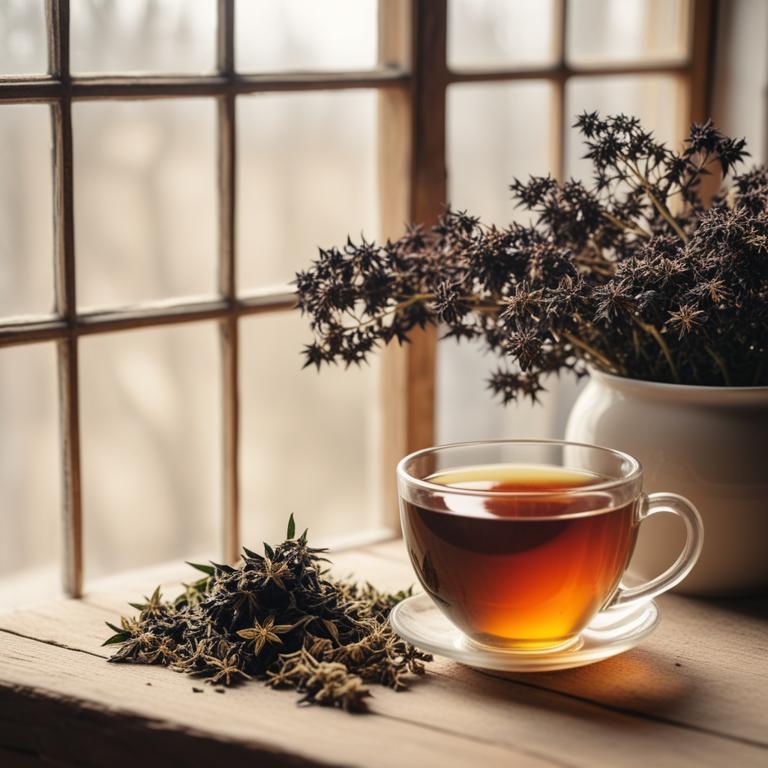
Sambucus nigra teas contains flavonoids, particularly quercetin and kaempferol, which are known for their anti-inflammatory properties.
These compounds help to reduce swelling and ease redness in the throat. The tea also contains phenolic acids, including caffeic and ferulic acid, which have antioxidant properties that combat oxidative stress and promote healing in the throat tissue. The bioactive constituents in Sambucus nigra teas, such as glycosides and saponins, work together to soothe and protect the mucous membranes in the throat, alleviating redness and discomfort.
Regular consumption of Sambucus nigra teas may help to maintain a healthy throat and prevent infections.
- Gather 1 tablespoon of dried Sambucus nigra flowers and 1 cup of boiling water.
- Pour the boiling water over the dried flowers in a cup or teapot.
- Let it steep for 5-7 minutes, then strain the liquid.
- Add 1 tablespoon of honey (optional) to sweeten the tea.
- Drink the tea 2-3 times a day to help soothe throat redness.
7. Mentha x piperita
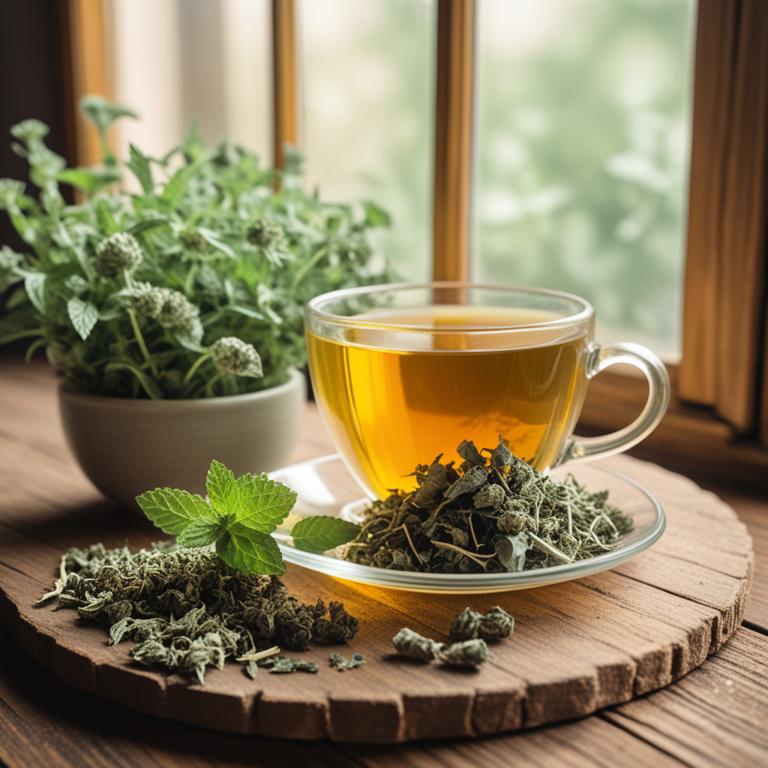
Mentha x piperita teas contains rosmarinic acid, eugenol, and menthol as its bioactive constituents.
These compounds have anti-inflammatory and antimicrobial properties that help reduce throat redness by combating infections and calming irritation. Rosmarinic acid specifically targets and inhibits the production of inflammatory chemicals, such as prostaglandins and leukotrienes, which contribute to redness and swelling. Eugenol has natural analgesic and antiseptic properties that soothe and protect the throat from further irritation.
The menthol in Mentha x piperita teas also helps to thin mucus, making it easier to expel and providing temporary relief from congestion.
- Gather 1 cup of fresh peppermint leaves (Mentha x piperita) and 1 cup of boiling water.
- Measure 1 tablespoon of honey and set it aside.
- Chop the peppermint leaves and place them in a heat-resistant cup.
- Pour the boiling water over the peppermint leaves and let it steep for 5-7 minutes.
- Strain the tea and mix in the honey. Drink while warm to soothe throat redness.
8. Salvia officinalis
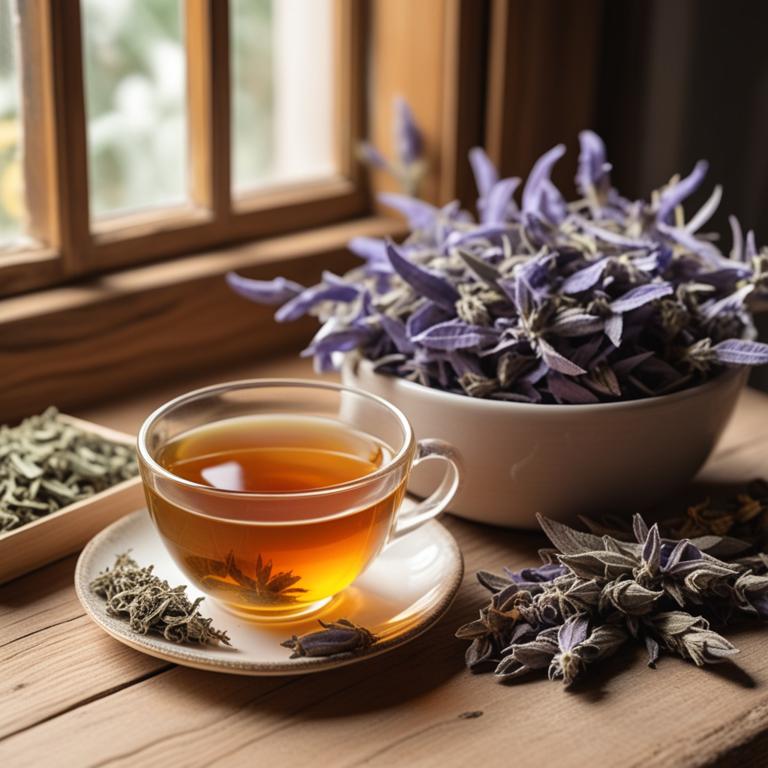
Salvia officinalis teas contains bioactive compounds like rosmarinic acid, luteolin, and apigenin, which have anti-inflammatory properties.
These compounds help reduce swelling and redness in the throat by blocking the production of inflammatory chemicals. The flavonoids present in Salvia officinalis, such as luteolin, also have antioxidant properties that help protect the throat from damage caused by free radicals. The anti-inflammatory and antioxidant properties of Salvia officinalis help soothe and calm the throat, reducing redness and discomfort.
The herb's antimicrobial properties, attributed to compounds like carnosic acid, also help prevent infections that can cause throat redness.
- Gather 1 cup of fresh or dried Salvia officinalis leaves.
- Measure 1 tablespoon of the leaves and place them in a cup.
- Pour 1 cup of boiling water over the leaves and let it steep for 5-7 minutes.
- Strain the liquid and discard the leaves. Let it cool down.
- Drink the tea 2-3 times a day to help soothe throat redness.
9. Lavandula angustifolia

Lavandula angustifolia teas contains linalool and linalyl acetate, two biologically active constituents that have anti-inflammatory properties.
These compounds help reduce swelling and ease pain in the throat, making them effective in alleviating redness. Linalool also has antimicrobial properties, which can help combat infections and promote a healthy environment for the throat tissue to heal. The antiseptic and anti-inflammatory effects of linalyl acetate and linalool work together to soothe and calm the throat, making Lavandula angustifolia teas a good choice for relieving throat redness.
By reducing inflammation and promoting a balanced environment, this herbal tea can help alleviate discomfort and promote a healthy throat.
- Gather 1 cup of dried Lavandula angustifolia flowers.
- Heat 1 cup of water in a pot.
- Add 2 tablespoons of dried Lavandula angustifolia flowers to the hot water.
- Steep for 5-7 minutes, then strain the mixture.
- Drink the tea warm or at room temperature to soothe throat redness.
10. Achillea millefolium
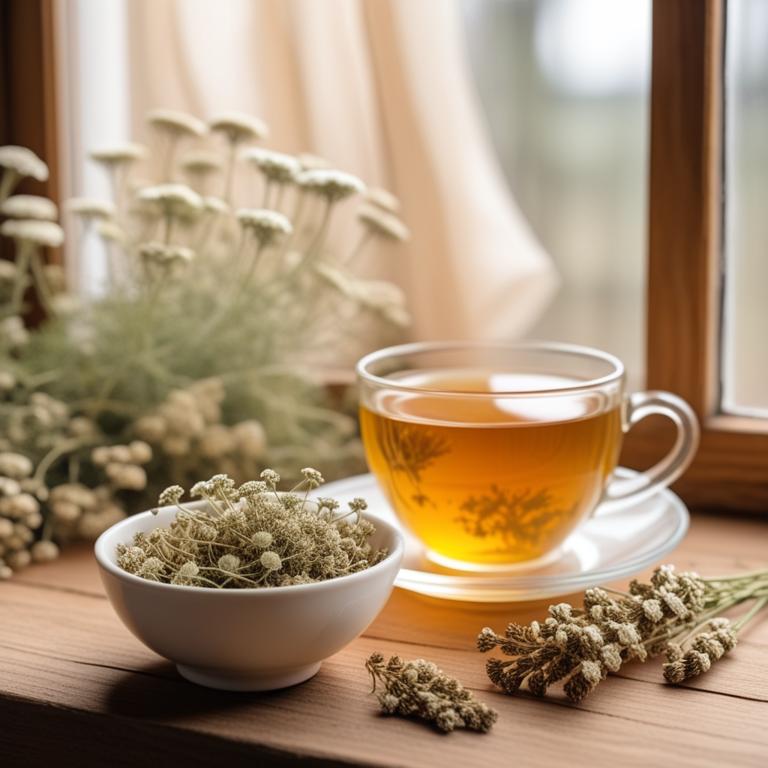
Achillea millefolium teas contains sesquiterpene lactones, flavonoids, and tannins as its bioactive constituents.
These compounds have anti-inflammatory and antioxidant properties, which help soothe and calm the throat, reducing redness and discomfort. The sesquiterpene lactones, specifically inulin and alantolactone, exhibit anti-inflammatory activity by inhibiting the production of pro-inflammatory enzymes. Flavonoids, such as kaempferol and quercetin, possess antioxidant properties that protect the throat from oxidative stress, further reducing inflammation and redness.
By using Achillea millefolium teas, the bioactive constituents can help alleviate throat redness by addressing the underlying causes of inflammation and oxidative stress.
- Gather 1 cup of dried Achillea millefolium leaves or 2 tablespoons of fresh leaves.
- Combine the leaves with 1 cup of boiling water in a heat-resistant cup.
- Steep for 5-7 minutes, then strain the mixture using a fine-mesh sieve or cheesecloth.
- Add honey to taste, if desired, and stir well to combine.
- Drink the tea warm or at room temperature to help soothe throat redness.
11. Rosmarinus officinalis

Rosmarinus officinalis teas contains carnosic acid and rosmanol as its bioactive constituents.
These compounds have anti-inflammatory and antioxidant properties, which help to reduce swelling and irritation in the throat. The antioxidant properties of carnosic acid and rosmanol also help to protect the throat tissues from oxidative damage, promoting a healthy environment for healing. Additionally, the anti-inflammatory properties of these compounds help to reduce redness and inflammation, making it easier for the throat to recover from irritation.
By drinking Rosmarinus officinalis teas, you can help to soothe and calm the throat, providing relief from redness and discomfort.
- Gather 1 cup of fresh or dried Rosmarinus officinalis leaves.
- Measure 1 tablespoon of the leaves and place them in a tea infuser or a heat-resistant cup.
- Heat 1 cup of water in a kettle or on the stove until it reaches 212°F (100°C).
- Pour the hot water over the Rosmarinus officinalis leaves and let it steep for 5-7 minutes.
- Strain the tea and drink it warm or at room temperature to help soothe throat redness.